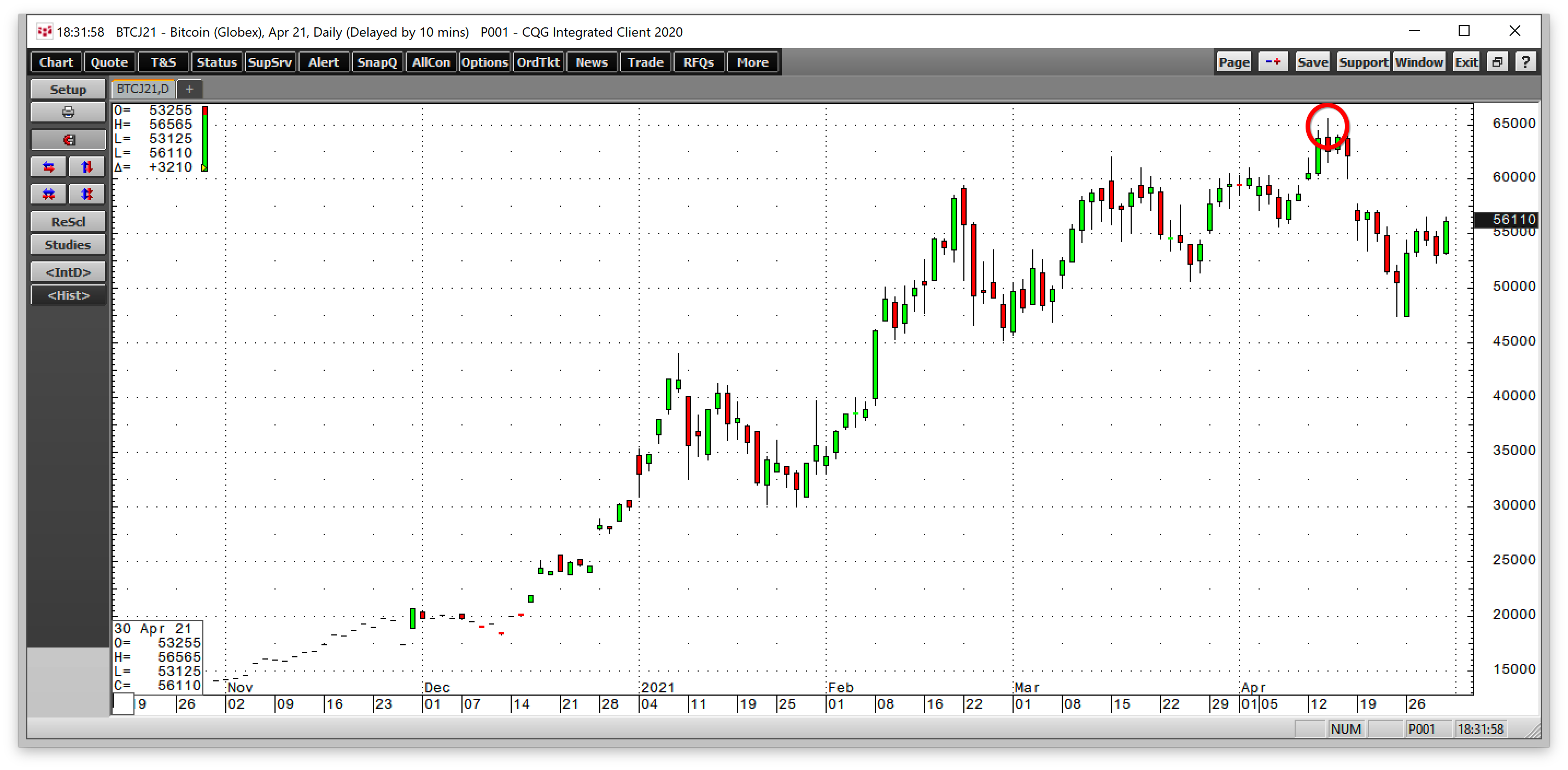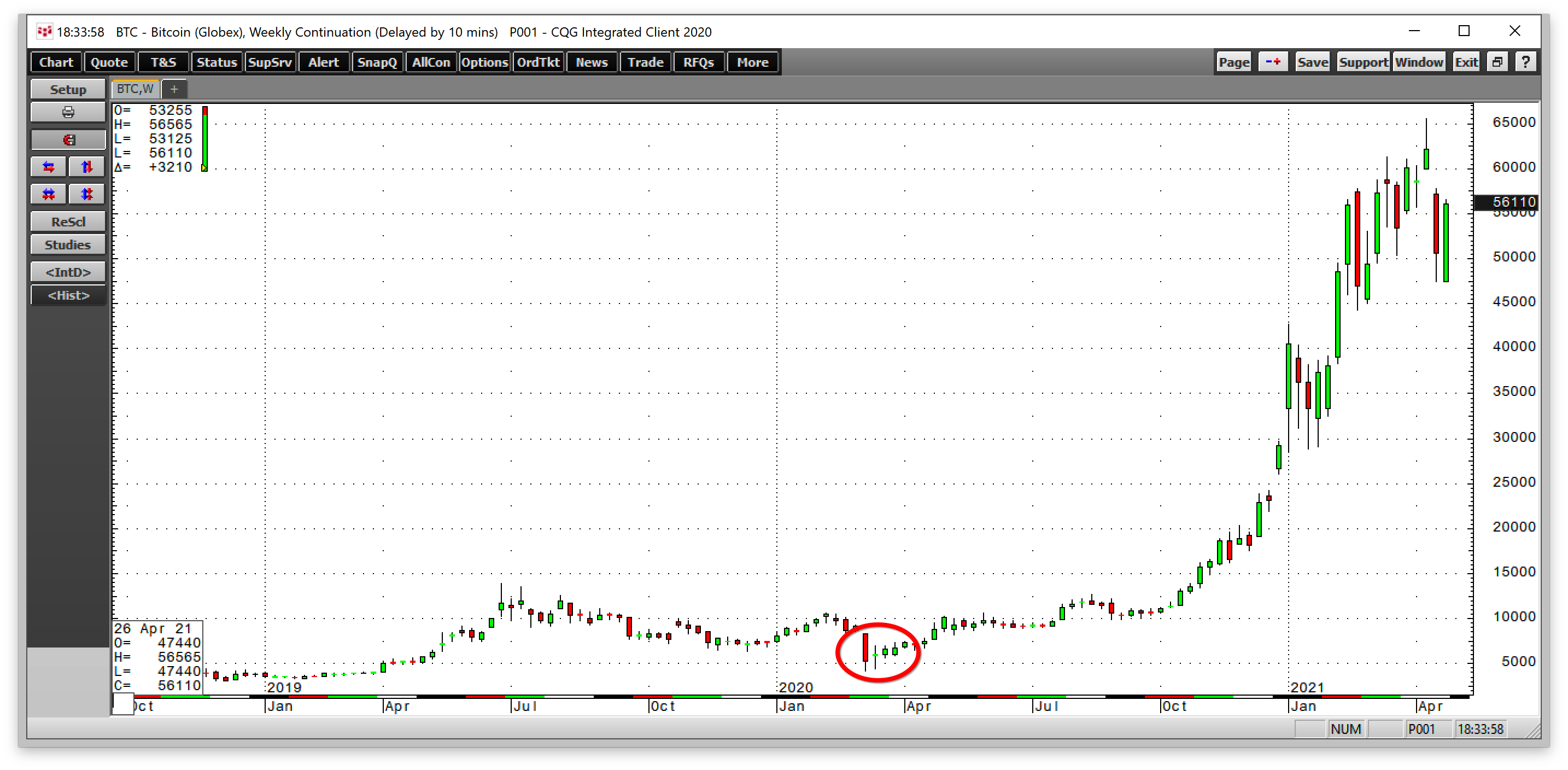This article was written exclusively for Investing.com
- The Coinbase listing marked a peak for Bitcoin
- Ethereum also pulled back
- Parabolic moves rarely end well; three reasons it could lead to carnage
- Prices could still head much higher, but from much lower levels
- Be careful in cryptos...only allocate funds you can afford to lose
After reaching a high of $65,520 per token on Apr. 14, Bitcoin pulled back to below $50,000 before the end of the month. Ethereum, the second leading cryptocurrency, fell from $2,564.50 on Apr. 22 to just over the $2,060 level before making a comeback and new high at $2803.75 as April came to a close. The market cap of all digital currencies rose to roughly $2.3 trillion, fell to the $1.80 trillion level, and was back at over the $2.18 trillion level on Apr. 30.
Bitcoin, the asset class’s leader, moved from six cents in 2010 to over $65,500 in 2021. The appreciation is unprecedented. While many market participants believe the asset class will continue to grow, the road ahead may be very bumpy. After all, Bitcoin rose to a high of $20,650 in late 2017 and then plunged to a low of $3,120, one year later in December 2018, a decline of nearly 85%. A similar correction would take Bitcoin to below the $10,000 level.
Everyone loves a bull market, and the ascent of cryptocurrencies has sparked a period of wild speculation. Many market participants are looking for the next token that will reward them with Bitcoin-like returns. Meanwhile, as more capital flows into the asset class, the chances of a systemic reaction in markets increase. At the $2.18 trillion level, a sharp correction may not trigger the next substantial financial crisis, but it may not be the case in the coming years.
The Coinbase Listing Marked A Peak For Bitcoin
It is no coincidence that the most recent high in Bitcoin came on Apr. 14, the day of the Coinbase (NASDAQ:COIN) listing. 
Source, all charts: CQG
The daily chart of CME Bitcoin futures shows that the peak came on Apr. 14 at $65,520 per token. Bitcoin is the leader of the crypto pack and the bellwether token.
Bitcoin has rallied after each significant event over the past years. The first rally came as the CME rolled out futures, pushing the price to $20,000. In late 2020, the price rose to a new high and kept on climbing in early 2021 as companies invested in the digital currency. Bitcoin investments by Square (NYSE:SQ) and Tesla (NASDAQ:TSLA), and acceptance of the token by a growing number of companies for products and services, lit a bullish fuse.
Meanwhile, as the confidence in central banks and fiat currencies declines, digital currencies have seen their market share increase. Bitcoin dropped around $15,000 from its Apr. 14 high, but the price snapped back to the $56,110 level and beyond as the price digests the recent new high and consolidates.
Ethereum Remains Strong
Ethereum is the second-leading cryptocurrency. It has outperformed Bitcoin over the past weeks. While Bitcoin remains below its Apr. 14 high, Ethereum tokens have continued to make higher highs. Ethereum only began trading in the futures market on Feb. 8. 
As the chart shows, Ethereum reached one of its higher highs on Apr. 29 at $2803.75 and is currently trading beyond that, over $3,100 at time of writing, as the trend remains bullish. Ethereum has continued to power higher.
Parabolic Moves Rarely End Well; Three Reasons It Could Lead To Carnage
It is virtually impossible to pick bottoms or tops in markets. A price can drop to unforeseen levels when markets decline into a bearish abyss.
Last year, on Apr. 20, the price of nearby NYMEX crude oil futures fell below zero to a low of negative $40.32 per barrel as the energy commodity became a bearish hot potato. Few market participants saw that coming.
Prices can rise to levels that most market participants believe are irrational, unreasonable, and illogical during bull markets. Parabolic price action can be explosive, as we have seen in the cryptocurrency asset class.
Meanwhile, bottoms or tops eventually develop, leading to price reversals. Three compelling factors could potentially end the parabolic rallies in cryptocurrencies:
- Rising taxes in the US could trigger selling in the crypto patch. When President Joseph Biden discussed his proposal to more than double the capital gains tax rate for the wealthiest Americans, Bitcoin’s price dropped. Many market participants have significant gains in cryptocurrencies. Higher tax rates could trigger selling.
- Regulations on the asset class are another factor that could cause significant selling. Since cryptocurrencies threaten the government’s control of the money supply, a ban or limitations on the digital currency arena could end the bullish price action.
- Competition from government-issued digital currencies could decrease the demand for cryptos when the US, Europe, China, and other countries begin issuing tokens.
Meanwhile, an overall market correction, where markets across all asset classes suffer declines, could end the parabolic move in the cryptocurrencies. In mid-March 2020, when the global pandemic caused selling in all markets, Bitcoin’s price plunged. 
As the weekly chart shows, Bitcoin traded to a low of $4,210 per token during the week of Mar. 9, 2020. The market cap of the digital currencies market remains relatively small at the $2.18 trillion level. Compare that to Apple’s (NASDAQ:AAPL) market cap which is currently over $2.24 trillion.
Therefore, a sudden and severe correction would not likely trigger panic in other markets right now. However, the higher the asset class’s market cap rises over the coming years, the greater the chances of an increase in systemic risk for other markets.
Prices Could Still Head Much Higher, But From Much Lower Levels
I am bullish on the prospects for the digital currency asset class for the coming years. Cryptocurrencies are a natural offshoot of modern technology. Fintech, or technology in the financial arena, is here to stay. Blockchain technology is revolutionizing finance as it increases transaction speeds and efficiency.
Even if the parabolic price action that began in March 2020 ends, the digital currencies are likely to continue to gain acceptance given central bank and government policies.
One of the global pandemic’s side effects has been the tidal wave of central bank liquidity and tsunami of government stimulus. The money supply is exploding higher along with deficits and debt levels in the US and worldwide. While vaccines create herd immunity to the virus, the economic legacy will remain a factor in the coming years.
Cryptocurrencies' ideology is libertarian; it rejects government intervention in money. Government policies to combat the pandemic’s impact on the economy only further the case for a means of exchange that takes power from the government and returns it to free markets.
While government action could cause a significant correction in the digital currency arena, it is likely to be a temporary event. The trend of rejecting authority over the currency markets has picked up a head of steam that will be difficult, if not impossible, to reverse. Any significant selling in cryptocurrencies would likely lead to higher bottoms and higher highs in the future as the supply of tokens is limited.
Be Careful Investing In Cryptos...Only Allocate Funds You Can Afford To Lose
Everyone loves a bull market. Human nature makes us want to jump on board. Bitcoin went from 6 cents to $65,520, which turned $1 into over $1,000,000 for some of the earliest buyers. The wealth creation is a powerful force for market participants looking for the next token to explode or Bitcoin to continue to power higher to $100,000, $500,000, or higher.
Last week, JP Morgan Chase said that it would open a digital currency fund, allowing its wealthiest clients to participate in the market. A few short years ago, Jamie Dimon, the bank’s CEO and Chairman called Bitcoin a “fraud.” Warren Buffett, the famed value investor, called Bitcoin financial “rat poison squared.” Mr. Dimon’s bank is now offering digital currency investments to its best customers, and Mr. Buffett has been extremely quiet on the topic.
The best advice for approaching digital currencies is only to invest what you can afford to lose. Avoid leverage like the plague. Parabolic markets often reach unsustainable price levels. Corrections can take prices to levels that are far below where any analyst projects. When the herd tries to scramble out of a market at the same time, prices plunge.
Expect extreme volatility in the digital currencies, and you will not be disappointed. I would not be surprised to see Bitcoin at double the recent high or one-quarter of the Apr. 14 peak over the coming months. Exercise extreme caution in digital currencies to protect your hard-earned capital.
